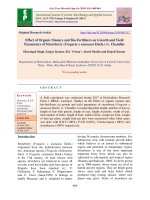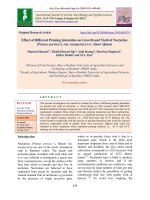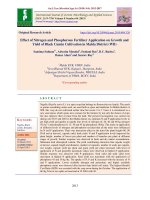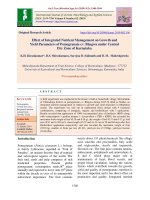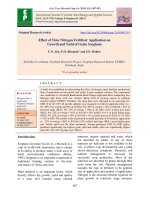Effect of nitrogen growth and yield of potato (Solanum tuberosum L.)
Bạn đang xem bản rút gọn của tài liệu. Xem và tải ngay bản đầy đủ của tài liệu tại đây (320.56 KB, 10 trang )
Int.J.Curr.Microbiol.App.Sci (2018) 7(1): 3311-3320
International Journal of Current Microbiology and Applied Sciences
ISSN: 2319-7706 Volume 7 Number 01 (2018)
Journal homepage:
Original Research Article
/>
Effect of Nitrogen Growth and Yield of Potato (Solanum tuberosum L.)
Debasis Mahata*, Mayukh Ghosh, Asok saha and Ashis Kumar Singha Roy
Department of Agronomy, Uttar Banga Krishi Viswavidyalaya,
Pundibari, Cooch Behar, West Bengal-736165, India
*Corresponding author
ABSTRACT
Keywords
Potato, Nitrogen,
Yield, Economics
Article Info
Accepted:
26 December 2017
Available Online:
10 January 2018
Potato (Solanum tuberosum L.) popularly known as ‘The king of vegetables’, has emerged
as fourth most important food crop in India after rice, wheat and maize. In the year 20022003, the production was 25 million tonnes while it was 5 million tonnes during 1970.
India ranks 4th in area and it is the 3rd largest country in world in production of potato after
China and Russian Federation. Potato is produced in an area of 14.00 lakh ha with a
production of 250 lakh tonnes and productivity of 17.86 ton per ha. In West Bengal area
under potato cultivation was 405.54 thousand ha, production was 7600 thousand tones
with a productivity of 21.383 t ha-1 (2007-08). The field experiment was carried out at the
Instructional farm of Uttar Banga Krishi Viswavidyalaya, Pundibari, Cooch Behar, West
Bengal during the rabi season of 2009-10 and 2010-11. Experiment was laid out in a
Randomized Block Design with eight different levels of nitrogen: 75 Kg N /ha (T1), 90 Kg
N /ha (T2), 105 Kg N /ha (T3), 120 Kg N /ha (T4), 135 Kg N /ha (T5), 150 Kg N /ha (T6),
165 Kg N /ha (T7) and 180 Kg N /ha (T8). The treatments were replicated thrice. The crop
management practices were optimum and an uniform dose of 100 kg P 2O5 and K2O/ha was
applied in all the plots. The seed tubers were planted on 8th December 2009 and 10th
December 2010 for the experimentation. The treatment 120 Kg N /ha (T4) recorded highest
values in most of the yield attributes. Tuber Bulking Rate was recorded maximum (52.55
and 63.21 during 2009-10) with the level of 120 kg N ha-1 at 40-60 and at 61-80 DAP.
Moreover, it was recorded maximum (53.08 and 63.84 during 2010-11) with the level of
120 kg N ha-1 at 40-60 and at 61-80 DAP. The maximum net return of Rs 31667.78 and
benefit cost ratio (0.49) was observed in the treatment T 4 which having the highest return
cost ratio at 2009-10. It was found that the same trend was followed in the next year i.e.
2010-11 with the maximum net return of Rs 34277.78 and benefit cost ratio (0.53). So, we
can say that at T4 the maximum return could be found and at T 7 and T8 higher dose of
nitrogen gave negative impact on yield and gave the lowest returns.
Introduction
Potato being a short duration crop, fits very
well in rice based cropping system even under
terai agro-climatic situation of West Bengal
where winter is prolonged and kharif rice is
harvested even in mid December in low lying
situation. There are many factors, which effect
the potato production under delayed planting
condition, however, nitrogen nutrition is of out
3311
Int.J.Curr.Microbiol.App.Sci (2018) 7(1): 3311-3320
most importance. Inadequate use of nitrogen
decreases potato yield by decreasing plant
growth characters. On the contrary, excess
nitrogen may also hinder its yield by reducing
translocation of photosynthates from top to
bottom.
In respect of success in potato cultivation in
India starting from the establishment of CPRI
in 1935, its cultivation has spread throughout
India and more than 80 per cent of its area is
concentrated in the Indo-Gangetic plains of
which about 74 percent area is in the states of
Uttar Pradesh, Bihar and West Bengal and 82
per cent share in the total potato production.
Among the states, West Bengal, basically a
rice growing area becomes the second largest
producer of potato after Uttar Pradesh with
their respective production of 133,910 and
135.770 lakh tonnes during 2010-2011
(Horticulture Statistics Division Department
of agriculture and Cooperation).
In West Bengal, the total cultivated area
under potato was 3.427 lakh hectares during
2010-2011, which was higher than that of
3.158 lakh hectares in the year 2000-2001.
Potato production increased at about 2.4
million tonnes from 76.73 lakh tones obtained
in the year 2000-2001 to 79.13 lakh tonnes
during 2010-2011.
Potato being a short duration crop and for its
characteristic features of growing well under
wide range of temperature (150-250C),
variable climatic condition, different soil
types, pH ranging from 5.5-7.5 and wide
flexibility in planting time, it can be fitted
very well in any intensive cropping system.
Even in the small farms, can be grown
successfully as it can produce bulk in
relatively shorter time, which, in turn, could
meet up the demands of food for the rapid fast
growing populations of the developing
countries including India at the time of scares
in the decreasing problem of land resources.
Materials and Methods
The field experiment was carried out at the
Instructional farm of Uttar Banga Krishi
Viswavidyalaya, Pundibari, Cooch Behar,
West Bengal during the rabi season of 200910 and 2010-11. Experiment was laid out in a
Randomized Block Design with eight different
levels of nitrogen: 75 Kg N /ha (T1), 90 Kg N
/ha (T2), 105 Kg N /ha (T3), 120 Kg N /ha
(T4), 135 Kg N /ha (T5), 150 Kg N /ha (T6),
165 Kg N /ha (T7) and 180 Kg N /ha (T8). The
treatments were replicated thrice.
Emergence (%)
The emergence % was calculated from
randomly selected rows at 15 and 25 DAP in
each plot.
Number of stems plant-1
From the destructive sample of 5 plants the
number of tubers plant-1 was recorded at 20,
40, 60 days after sowing and at harvest. After
taking the destructive samples from each plot,
the number of stems plant-1 was recorded.
Fresh tuber weight (g plant-1)
All the counted tubers from the destructive
samples of five plants were separated from
stolon and fresh weight of tubers from five
plants was measured by electronic balance and
the average tuber weight plant-1 was worked
out at 20,40,60 days after planting and at
harvest.
Crop Growth Rate (CGR)
Crop growth rate can be calculated by the
following formula-
3312
W2 – W1
CGR =
T2 –T1
g m-2day-1
Int.J.Curr.Microbiol.App.Sci (2018) 7(1): 3311-3320
Where, W1& W2 were the dry weights of the
shoot (stem and leaves) at two successive time
intervals T1 and T2 respectively. This is the dry
matter accumulation unit-1 time and unit-1 land
area.
40-60 days,60-80 days and between 80 and
harvest were calculated and mean results were
presented in the table.
Relative Growth Rate (RGR)
This is supplementary index to indicate the
amount of capital resources needed to adopt
particularly cropping system. Even one system
gives higher gross/net income; the farmer may
choose another system with less profit which
also involves less capital investment because
of their limited capital resources. In preparing
the cost of cultivation, it is customary to
indicate the expenditure incurred on different
items such as labour (including family labour),
seeds, chemicals (fertilizer and pesticides) and
power (tractor and power tiller and pumping
water) etc. This will help the farmer to choose
a system which uses the resources he has in
plenty but demands less on the resources he
lacks.
Relative growth rate can be calculated by the
following formulaLog e W2 – Log e W1
RGR = --------------------------------- g g-1day-1
T2 –T1
Where, W1& W2 were the dry weight of the
plant at two successive time intervals T1&T2
respectively. This is the dry matter
accumulation unit-1 time and unit-1 land area.
Net Assimilation Rate (NAR)
Net assimilation rate can be calculated by the
following formula(W2-W1) (Log e L2 – Log e -L1)
NAR =
g m-2 day-1
(T2 –T1) (L 2- L1)
It is expressed as g of dry matter produced per
mm2 of leaf area in a day. Where, W1& W2
were the dry weight of the plant and L1 and L2
were leaf area at two successive time intervals
T1 and T2 respectively. This is the dry matter
accumulation unit-1 time and unit-1 land area.
Cost of cultivation
Economics analysis
The total cost of cultivation was calculated
considering the expenditure on land
preparation, seed material, sowing, weeding,
gap filling and cost of fertilizer, manures,
plant protection, harvesting etc. and bacterial
inoculation depending upon the particulars of
treatments of different crops. The return:cost
ratio was calculated by dividing total product
value with total cost of cultivation against
each treatment.
Total return from one ha.
Return to cost ratio =
Total cost of cultivation
Tuber Bulking Rate (TBR)
TBR was calculated as:W2 – W1
TBR =
g m-1day-1
T2 –T1
Result and Discussion
Effect of nitrogen on emergence (%)
Where, W1&W2 are the dry weights of tubers
in unit area of land at two successive time
intervals T1& T2, respectively. Tuber bulking
rate (TBR) in gm-2day-1 between 30-40 days,
The results of the emergence percentage for
different treatments observed at 15, and at 25
DAP were presented in the Table 1.
3313
Int.J.Curr.Microbiol.App.Sci (2018) 7(1): 3311-3320
The results showed that there was significant
difference in emergence percentage at all the
stages of recording observation with the
different levels of nitrogen. It was recorded
maximum (59.10 and 92.84% during 2009-10)
with the level of 120 kg N ha-1 and minimum
(40.33 and 82.36% during 2009-10) with the
N level of 180 kg N ha-1 at 15 and at 25 DAP.
Moreover, it was recorded maximum (59.69
and 93.77% during 2010-11) with the level of
120 kg N ha-1 and minimum (40.33 and
83.18% during 2010-11) with the N level of
180 kg N ha-1 at 15 and at 25 DAP.
increasing Nitrogen application rates upto 250
kg N ha-1 resulted significant increases in large
and medium tuber yields and reduction in
tuber dry matter.
The poor emergence was mainly due to late
planting and low night temperature (below
150C) prevailed during the time of
observation. Similar result was observed by
Brajesh and Ezekiel (2001).
Effect of nitrogen on crop growth rate (g
m-2 day-1)
Effect of nitrogen on number of stem
plant-1
The results of the number of stem plant-1for
different treatments observed at 20, 40 and at
60 DAP were presented in the Table 2.
The results showed that there was significant
difference in number of stem plant-1 at all the
stages of recording observation with the
different levels of nitrogen. It was recorded
maximum (2.00, 3.00 and 6.00 during 200910) with the level of 120 kg N ha-1 and
minimum (1.33, 1.99 and 3.98 during 200910) with the N level of 180 kg N ha-1 at 20, 40
and at 60 DAP. Moreover, it was recorded
maximum (2.25, 3.37 and 6.74 during 201011) with the level of 120 kg N ha-1 and
minimum (1.42, 2.13 and 4.26 during 201011) with the N level of 180 kg N ha-1 at 20, 40
and at 60 DAP.
Anabousi et al., (1997) reported that potato
were given 0, 125, 250 or 375 kg N ha-1and
resulted significant increase in plant height,
stem number plant-1. It was also found that
Veer et al., (2002) observed the effects of
Nitrogen (75, 100, 125, 150 and 175 kg N
ha-1) on the bulking rates of potato cv. Kufri
Sutlej. Plant height, number of stems hill-1,
leaf fresh weight, number of tubers hill-1, dry
matter content, yield of different grade tubers,
mean total tuber yield and tuber bulking
increased with increasing rates of N.
The results of the crop growth rate (CGR) for
different treatments observed at 20-40 and at
41-60 DAP were presented in the Table 3.
The results showed that there was significant
difference in emergence percentage at all the
stages of recording observation with the
different levels of nitrogen. It was recorded
maximum (3.90 and 9.50 during 2009-10)
with the level of 120 kg N ha-1 and minimum
(2.34 and 2.27 during 2009-10) with the N
level of 180 kg N ha-1 at 20-40 and at 41-60
DAP. Moreover, it was recorded maximum
(3.94 and 9.60 during 2010-11) with the level
of 120 kg N ha-1 and minimum (2.36 and 2.29
during 2010-11) with the N level of 180 kg N
ha-1 at 20-40 and at 41-60 DAP.
Patel et al., (2000) reported that application of
different doses of nitrogen at the rate of 180,
220 and 260 kg ha-1 and the highest dry weight
of shoots and tubers plant-1, LAI, CGR and
NAR were recorded at 260 kg N ha-1.
The higher crop growth rate among the
cultivars might be due to higher leaf area
indices and higher dry matter accumulation.
The result corroborated the findings of
Fernando (1958).
3314
Int.J.Curr.Microbiol.App.Sci (2018) 7(1): 3311-3320
The crop growth rate was initially low,
reached its peak between 41-60 days after
planting due to the increased accumulation of
dry matter which resulted in an increase in
crop growth rate value with all the cultivars.
Furthermore, the dry matters increased
linearly upto 60 days after planting in each
cultivar. So, the crop growth rate was found to
be highest between 41 and 60 days after
planting. The result corroborated the findings
of Fernando (1958).
Effect of nitrogen on relative growth rate (g
g-1 day-1)
The results of the relative growth rate (g g-1
day-1) for different treatments observed at 20-
40 and at 41-60 DAP were presented in the
Table 4. The results showed that there was
significant difference in relative growth rate (g
g-1 day-1) at all the stages of recording
observation with the different levels of
nitrogen. It was recorded maximum (0.171and
0.076 during 2009-10) with the level of 120
kg N ha-1 and minimum (0.137 and 0.044
during 2009-10) with the N level of 180 kg N
ha-1 at 20-40 and at 41-60 DAP. Moreover, it
was recorded maximum (0.173 and 0.077
during 2010-11) with the level of 120 kg N
ha-1 and minimum (0.138 and 0.044 during
2010-11) with the N level of 180 kg N ha-1 at
20-40 and at 41-60 DAP. Similar result was
found by Hruska and Chloupek (1973) and
Midmore and Prange (1992).
Table.1 Effect of nitrogen on emergence (%)
Treatments
T1
T2
T3
T4
T5
T6
T7
T8
S.Em. (+)
C.D. (0.05)
2009-2010
20-40DAP
41-60DAP
40.26
85.25
42.85
87.57
45.65
88.50
59.10
92.84
54.23
91.23
43.33
90.36
41.30
83.39
40.33
82.36
0.0346
0.0262
0.1050
0.0795
2010-2011
20-40DAP
41-60DAP
40.66
86.10
43.28
88.45
46.11
89.39
59.69
93.77
54.77
92.14
43.76
91.26
41.71
84.22
40.73
83.18
0.0686
0.0475
0.2082
0.1441
20-40DAP
40.46
43.06
45.88
59.40
54.50
43.55
41.51
40.53
0.0516
0.1566
Pooled
41-60DAP
85.68
88.01
88.94
93.30
91.69
90.81
83.81
82.77
0.0369
0.1118
Table.2 Effect of nitrogen on number of stem plant-1
2009-2010
2010-2011
Pooled
Treatments
20-40DAP 41-60DAP 20-40DAP 41-60DAP 20-40DAP 41-60DAP
1.47
2.20
4.40
1.57
2.35
4.70
T1
1.57
2.35
4.70
1.69
2.53
5.06
T2
1.77
2.65
5.30
1.87
2.80
5.60
T3
2.00
3.00
6.00
2.25
3.37
6.74
T4
1.87
2.80
5.60
2.00
3.00
6.00
T5
1.67
2.50
5.00
1.75
2.62
5.24
T6
1.55
2.32
4.64
1.63
2.44
4.88
T7
1.33
1.99
3.98
1.42
2.13
4.26
T8
0.0147
0.0510
0.0449
0.0146
0.0189
0.0470
S.Em. (+)
0.0446
0.1548
0.1363
0.0443
0.0572
0.1424
C.D. (0.05)
3315
Int.J.Curr.Microbiol.App.Sci (2018) 7(1): 3311-3320
Table.3 Effect of nitrogen on crop growth rate (g m-2 day-1)
Treatments
T1
T2
T3
T4
T5
T6
T7
T8
S.Em. (+)
C.D. (0.05)
2009-2010
20-40DAP 41-60DAP
2.42
4.94
2.44
6.22
2.54
6.94
3.90
9.50
3.36
8.68
3.18
6.12
2.40
3.23
2.34
2.27
0.0308
0.1164
0.0935
0.3529
2010-2011
20-40DAP 41-60DAP
2.44
4.99
2.46
6.28
2.57
7.01
3.94
9.60
3.39
8.77
3.21
6.18
2.42
3.26
2.36
2.29
0.0288
0.1050
0.0873
0.3185
Pooled
20-40DAP 41-60DAP
2.43
4.96
2.45
6.25
2.55
6.97
3.92
9.55
3.38
8.72
3.20
6.15
2.41
3.25
2.35
2.28
0.0298
0.1107
0.0904
0.3357
Table.4 Effect of nitrogen on relative growth rate (g g-1 day-1)
Treatments
T1
T2
T3
T4
T5
T6
T7
T8
S.Em. (+)
C.D. (0.05)
2009-2010
20-40DAP 41-60DAP
0.141
0.042
0.145
0.049
0.150
0.053
0.171
0.076
0.162
0.073
0.151
0.059
0.139
0.047
0.137
0.044
0.0054
0.0011
0.0165
0.0035
2010-2011
20-40DAP 41-60DAP
0.142
0.042
0.146
0.049
0.152
0.054
0.173
0.077
0.164
0.074
0.153
0.060
0.140
0.047
0.138
0.044
0.0023
0.0044
0.0070
0.0134
Pooled
20-40DAP 41-60DAP
0.142
0.042
0.146
0.049
0.151
0.053
0.172
0.076
0.163
0.073
0.152
0.059
0.140
0.047
0.138
0.044
0.0039
0.0028
0.0118
0.0085
Table.5 Effect of nitrogen on net assimilation rate (g m-2 day-1)
Treatments
T1
T2
T3
T4
T5
T6
T7
T8
S.Em. (+)
C.D. (0.05)
2009-2010
20-40DAP 41-60DAP
2.85
1.72
2.67
1.49
3.60
2.42
4.64
3.12
3.72
2.65
3.59
2.52
1.98
0.95
1.72
0.70
0.0354
0.0890
0.1073
0.2700
2010-2011
20-40DAP 41-60DAP
2.88
1.74
2.70
1.50
3.64
2.44
4.69
3.15
3.76
2.68
3.63
2.55
2.00
0.96
1.74
0.71
0.1105
0.0514
0.3351
0.1558
3316
Pooled
20-40DAP 41-60DAP
2.86
1.73
2.68
1.50
3.62
2.43
4.66
3.14
3.74
2.66
3.61
2.53
1.99
0.95
1.73
0.70
0.0730
0.0702
0.2212
0.2129
Int.J.Curr.Microbiol.App.Sci (2018) 7(1): 3311-3320
Table.6 Effect of cultivars on tuber bulking rate (fresh weight basis) g m-2d-1
Treatments
T1
T2
T3
T4
T5
T6
T7
T8
S.Em. (+)
C.D. (0.05)
2009-2010
20-40DAP 41-60DAP
39.45
55.25
40.32
56.22
48.76
58.21
52.55
63.21
51.06
62.33
42.32
61.43
38.41
52.37
37.39
50.12
0.0196
0.0561
0.0594
0.1700
2010-2011
20-40DAP 41-60DAP
39.84
55.80
40.72
56.78
49.25
58.79
53.08
63.84
51.57
62.95
42.74
62.04
38.79
52.89
37.76
50.62
0.0293
0.0968
0.0890
0.2936
Pooled
20-40DAP 41-60DAP
39.65
55.53
40.52
56.50
49.00
58.50
52.81
63.53
51.32
62.64
42.53
61.74
38.60
52.63
37.58
50.37
0.0245
0.0765
0.0742
0.2318
Table.7 Effect of nitrogen on final yield (t ha-1)
Treatments
T1
T2
T3
T4
T5
T6
T7
T8
S.Em. (+)
2009-2010
17.01
18.84
19.56
21.46
20.47
16.82
13.88
11.32
0.0607
2010-2011
17.42
19.32
20.07
22.04
21.01
17.23
14.18
11.53
0.0205
Pooled
17.22
19.08
19.82
21.75
20.74
17.03
14.03
11.43
0.0406
Table.8 Economics of cultivation of potato 2009-2010
Market Price Gross
Cost of
Net Return
Treatment Tuber
Yield
at Harvest
Return
Cultivation (Rs.)
(t/ha)
(Rs./t)
(Rs.)
(Rs.)
17.01
4500.00
76545.00
64348.18
12196.82
T1
18.84
4500.00
84780.00
64533.39
20246.61
T2
19.56
4500.00
88020.00
64717.01
23302.99
T3
21.46
4500.00
96570.00
64902.22
31667.78
T4
20.47
4500.00
92115.00
65085.84
27029.16
T5
16.82
4500.00
75690.00
65269.47
10420.53
T6
13.88
4500.00
62460.00
65454.68
-2994.68
T7
11.32
4500.00
50940.00
65638.25
-14698.3
T8
3317
R : C Ratio
0.19
0.31
0.36
0.49
0.42
0.16
-0.05
-0.22
Int.J.Curr.Microbiol.App.Sci (2018) 7(1): 3311-3320
Effect of nitrogen on net assimilation rate
(g m-2 day-1)
The results of the net assimilation rate (g m-2
day-1) for different treatments observed at 2040 and at 41-60 DAP were presented in the
Table 5.
The results showed that there was significant
difference in net assimilation rate (g m-2
day-1) at all the stages of recording
observation with the different levels of
nitrogen. It was recorded maximum (4.64 and
3.12 during 2009-10) with the level of 120 kg
N ha-1 and minimum (1.72 and 0.70 during
2009-10) with the N level of 180 kg N ha-1 at
20-40 and at 41-60 DAP. Moreover, it was
recorded maximum (4.69 and 3.15 during
2010-11) with the level of 120 kg N ha-1 and
minimum (1.74 and 0.71 during 2010-11)
with the N level of 180 kg N ha-1 at 20-40 and
at 41-60 DAP. Pravin et al., (2001) reported
the existence of distinct varietal differences in
net assimilation rate.
Effect of cultivars on tuber bulking rate
(fresh weight basis) (g m-2d-1)
The results of the tuber bulking rate (TBR)
for different treatments observed at 20-40 and
at 41-60 DAP were presented in the Table 6.
The results showed that there was significant
difference in emergence percentage at all the
stages of recording observation with the
different levels of nitrogen. It was recorded
maximum (52.55 and 63.21 during 2009-10)
with the level of 120 kg N ha-1 and minimum
(37.39 and 50.12 during 2009-10) with the N
level of 180 kg N ha-1 at 40-60 and at 61-80
DAP. Moreover, it was recorded maximum
(53.08 and 63.84 during 2010-11) with the
level of 120 kg N ha-1 and minimum (37.76
and 50.62 during 2010-11) with the N level of
180 kg N ha-1 at 40-60 and at 61-80 DAP.
Similar results was also obtained by Ivin and
Bremner (1965) who reported that tuber
bulking rate increased with increasing values
of leaf area index.
Veerana et al., (1997) reported that tuberbulking rate was greatest with 100% of the
recommended dose (125 kg N: 100 kg P2O5:
125 kg K2O ha-1).
Nandi et al., (2002) reported that tuber
bulking rate increased with increasing
fertilizer rates upto 240 kg N ha-1, 200 kg P
ha-1 and 200 kg K ha-1 and increasing the
fertilizer rate up to 300 kg N ha-1, 250 kg P
ha-1 and 250 kg K2O ha-1 had no beneficial
effect and in most cases exhibited declining
trends.
Effect of nitrogen on final yield (t ha-1)
The results of the final yield (t ha-1) for
different treatments observed at 2009-10 and
2010-11 were presented in the Table 7.
The results showed that there was significant
difference in final yield (t ha-1) in tubers at all
the stages of recording observation with the
different levels of nitrogen. It was recorded
maximum (21.46 t ha-1 during 2009-10) with
the level of 120 kg N ha-1 and minimum
(11.32 t ha-1during 2009-10) with the N level
of 180 kg N ha-1 at the time of harvest.
Moreover, it was recorded maximum (22.04 t
ha-1during 2010-11) with the level of 120 kg
N ha-1 and minimum (11.5 t ha-1during 201011) with the N level of 180 kg N ha-1 at the
time of harvest.
Kleinkopf et al., (1981) reported that
Nitrogen was applied at 170, 440 and570 kg
available N ha-1. Maximum daily tuber
growth rate was 0.9-1.3 t ha-1. High levels of
available N at planting delayed linear tuber
growth by 7-10 days with minor effects on
determinant cv.
3318
Int.J.Curr.Microbiol.App.Sci (2018) 7(1): 3311-3320
Juzl (1989) reported that potatoes were given
60, 120 or 180 kg N ha-1 and result showed
that 120 kg N ha-1 was recommended but
tuber yield were similar at higher N level.
Soaud et al., (1990) reported that potatoes
were given 0, 150-180 and 270-300 kg N ha-1
and high Nitrogen did not give significantly
higher yield.
Ramnik et al., (1999) reported that tuber yield
increased with increase in nitrogen levels.
Sud et al., (1999) reported that tuber yield of
Kufri Jyoti was increased with increasing
Nitrogen rate when it was applied with 0, 60,
120 or 180 kg N ha-1 at Kufri, Himachal
Pradesh.
Economics of cultivation of potato
From the economic point of view (Table 8)
the maximum net return of Rs 31667.78 and
benefit cost ratio (0.49) was observed in the
treatment T4 followed by the treatment T5
giving net return of Rs. 27029.16 and return
cost ratio (0.42), T4 having the highest return
cost ratio at 2009-10. From the table 8 it can
be seen that the same trend was followed in
the next year i.e. 2010-11 with the maximum
net return of Rs 34277.78 and benefit cost
ratio (0.53) was observed in the treatment T4
followed by the treatment T5 giving net return
of Rs. 29459.16 and return cost ratio (0.45).
So, we can say that at T4 the maximum return
could be found and at T7 and T8 higher dose
of nitrogen gave negative impact on yield and
gave the lowest returns.
References
Anabousi, O.A.N., Hattar, B.I. and Suwwan,
M.A. 1997. Effect of rate and source of
nitrogen on growth, yield and quality of
potato under Jordan Valley conditions.
Dirasat Agric. Sci. 24(2): 242-259.
Brajesh S and Ezekiel R. 2010. Isopropyl n(3-chlorophenyl) carbamate (CIPC)
residues in potatoes stored in
commercial cold stores in India. Potato
Res. 53:111–120.
Fernando, L. H. 1958. Studies on leaf growth:
effect of mineral nutrients and the
interdependence of the leaves of a plant.
Ph.D., Thesis, Univ. London.
Hruska, L. and Chloupek, O. 1973. Some data
on yield formation for different plant
densities. Nektere poznalky tvorvy
Vynosupri ruzne organizaci porostu.
Vedecke prace Vyzkumneho ustavu
Bramborarskcho V. Havlickove Brode.
5:101-108.
Juzl, M. 1989. An assessment of yield in very
early potato plants at different rates of
nitrogen fertilizer. Acta Univ. Agri.
Facultas Agronomic. 37(3-4):115-122.
Kleinkopf, G.E., Westermann, D.T. and
Dwelle, R.B. 1981. Dry matter
production and nitrogen utilization by
six potato cultivars. Agron. J. 73(5):
799-802.
Midmore, D. J. and Prange, R. K. 1992.
Growth responses of two Solanum
species to contrasting temperatures and
irradiance
levels:
relations
to
photosynthesis, dark respiration and
chlorophyll fluorescence. Annals-ofBotany; 69(1): 13-20.
Nandi, P.D. Mandal and D.C. Ghosh. 2002.
Fertility management in seedling tuber
production from true potato seed (TPS).
Hort. J. 15(3): 43-52.
Pravin, Prakash; Chetti, M. B. and Patil, S. S.
2001. Effect of plant growth regulators
on growth parameters and yield in
potato.
Karnataka
Journal
of
Agricultural Sciences; 14(4): 938-942.
Ramnik, Sharma., Dubey, Y.P., Kaistha, B.P.
and Sharma, R. 1999. Influence of
irrigation and nitrogen on yield, total
water expense and water expense
efficiency of potato in Lahaul valley of
3319
Int.J.Curr.Microbiol.App.Sci (2018) 7(1): 3311-3320
Himalayas. J. Indian Soc. Soil Sci. 47
(1): 19-22.
Soaud, A.A., Hofman, G. and Cleemput-OVan Cleemput-O. 1990. Nitrogen
fertilization
and
potato
growth.
Pedologic. 40 (3): 257-271.
Sud, K.C., Verma, B.C. and Sharma, R.C.
1999. Nitrogen and sulphur role in
potato (Solanum tuberosum) nutrition
on brown hill soil of Shimla. Indian
J.Agric. Sci. 69 (2): 118-121.
Veer, Kumar., Narendra, Singh., Malik, Y.S.,
Bhatia, A.K., Nehra, B.K., Kumar, V.
and Singh, N. 2002. Effect of nitrogen
and crop duration on bulking behaviour
of potato cv. Kufri Sutlej. Haryana J.
Hort. Sci. 31 (3-4): 259-261.
Veeranna,
H.K.,
Abdul,
Khalak.,
Krishnamurthy, N., Mudalagiriyappa.
and Khalak, A. 1997. Effect of spacing
and fertilizer levels on ware potato yield
and quality of tubers obtained through
'TPS' seedlings. Indian Agric. 41 (1):
31-36.
How to cite this article:
Debasis Mahata, Mayukh Ghosh, Asok saha and Ashis Kumar Singha Roy. 2018. Effect of
Nitrogen Growth and Yield of Potato (Solanum tuberosum L.). Int.J.Curr.Microbiol.App.Sci.
7(01): 3311-3320. doi: />
3320


